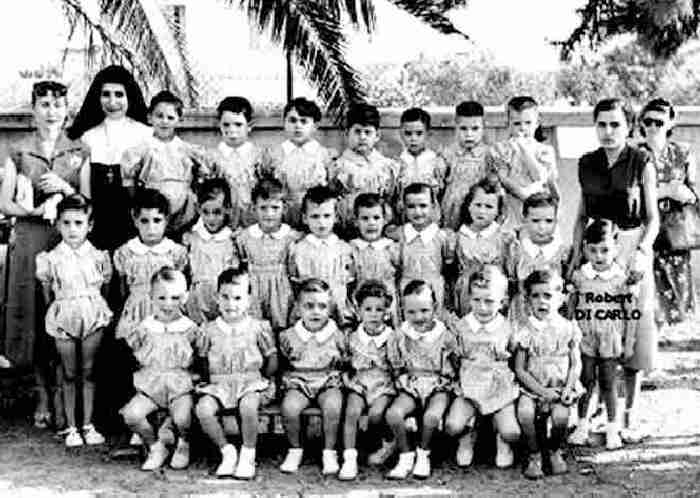
Colonial Tunisian School: Unidentified School

Figure 1.-- We do not know much about the school, but the younger boys had a romper uniform. This looks like a Kindergarden class. It is not dated, but the child noted was born in 1945. We would guess this would mean that the photograph was taken in 1949 or 50. We have seem other schools in which the nursery school on kingdergardem class wore rompers. This was usually done because mothers chose rompers and not becaise the school required rompes. Here these patterened rompers were clearly a required school uniform.
|
We have only limited information on Tunisia at this time. As is common for the Middle East and North Africa, we have been able to find some information about European colonial schools, but little information about Tunisian post-independence schools. We do not fully understand this dichotomy at this time. Tunisia was a French colony. One reader has mentioned an unidentified school at Ferryville, a suburb of Bizerte. After independence in 1956 the town was renamed Menzel Bourghiba to honor of Tunisia's first president. We do not know much about the school at this time. The children look mostly French to us. We are not sure what type of school it was or what the admissions policy was. Almost certainly the classes were conducted in French. Here we see that the younger boys had a romper uniform. This looks like a Kindergarden class. It is not dated, but the child noted was born in 1945. We would guess this would mean that the photograph was taken in 1949 or 50. We have seem other schools in which the nursery school on kingdergardem class wore rompers. This was usually done because mothers chose rompers and not becaise the school required rompers. Here these patterened rompers were clearly a required school uniform.
French Colonial Schools
We have only limited information on Tunisia at this time. Tunisia was a French colony. As is common for the Middle East and North Africa, we have been able to find some information about European colonial schools, but little information about Tunisian post-independence schools. We do not fully understand this dichotomy at this time. The "Pied-Noir association " from Bizerte
tells us, "All the schools were taught in French. It was compulsory at the time. The children were dressed exactly like chikldren in France. It must be considered of course that in Tunisia they wore warm weather Summer clothes during much of the yearrather than the warmer clothing worn in the eastern and mountanious region of France."
Ferryville
Ferryville was a suburb of Bizerte located on the northern side of the city. Bizerte was a major port and the most important French naval base in North Africa. Thus it had a substantial French population. Ferryville was the site of the last important battle of the World War II North African campaign. The German Afrika Korps dug in at Ferryville in an attempt to save their last supply port at Bizerte. Allied armor broke through leading to the fall of Bizerte. The German commander surrendered a few days later (May 1943). After independence in 1956 the town was renamed Menzel Bourghiba to honor of Tunisia's first president. Ferryville is very known !
Unidentified School
One reader has mentioned an unidentified school at Ferryville. We do not know the name ofthe school. The children look mostly French to us. We are not sure what type of school it was or what the admissions policy was. Almost certainly the classes were conducted in French.
School Clothing
Here we see that the younger boys had a romper uniform. This looks like a Kindergarden class. It is not dated, but the child noted was born in 1945. We would guess this would mean that the photograph was taken in 1949 or 50. We have seem other schools in which the nursery school on kingdergardem class wore rompers. This was usually done because mothers chose rompers and not becaise the school required rompes. Here these patterened rompers were clearly a required school uniform. A French reader tells us, Durung the late 1940s and early 50s it was quite common for French boys to wear rompers like the one seen at the Tunisian school here. Boys wore rompers like this to school up to about 7 years of age. It was not the most common outfit, but it was quite common for a few boys even after kindergarden to wear them to school. It was even more common on Thursday (our free day) and on Sunday for Church."
HBC-SU

Navigate the HBC North African School Pages
[Morocco]
[Algeria]
[Tunisia]
[Libya]
[Egypt]
Related Style Pages in the Boys' Historical Web Site
[Long pants suits]
[Knicker suits]
[Short pants suits]
[Rompers]
[Socks]
[Eton suits]
[Jacket and trousers]
[Blazer]
[School sandals]
Navigate the Boys' Historical Clothing Web Page
[Main Tunisian school page]
[Main school country page]
[Introduction]
[Activities]
[Biographies]
[Chronology]
[Cloth and textiles]
[Clothing styles]
[Countries]
[Topics]
[Bibliographies]
[Contributions]
[FAQs]
[Glosario en Espaņol]
[Satellite sites]
[Tools]
[Boys' Clothing Home]
Created: 2:07 AM 4/8/2005
Last updated: 5:09 AM 4/8/2005




